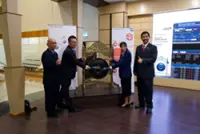In partnership with a guide dog training school, engineers at Google Research have developed highly original technology that involves walking (or running) along a path defined by a yellow line painted on the ground. — AFP Relaxnews
New technologies could soon make life easier for visually impaired people. Many researchers around the world are working on projects to facilitate their mobility and independence. On World Sight Day, here's a look at some of the most spectacular projects underway.
Many startups are working on solutions to make life easier for visually impaired people. Among the few products already available on the market is Rango, developed by the Lyon, France-based startup GoSense. It is a connected module that makes white canes more intelligent. Users can expect to move around safely, as this accessory can detect the slightest obstacle in the vicinity, including those at height, which are usually undetectable by a simple white cane.
Already a subscriber? Log in
Save 30% OFF The Star Digital Access
Cancel anytime. Ad-free. Unlimited access with perks.





